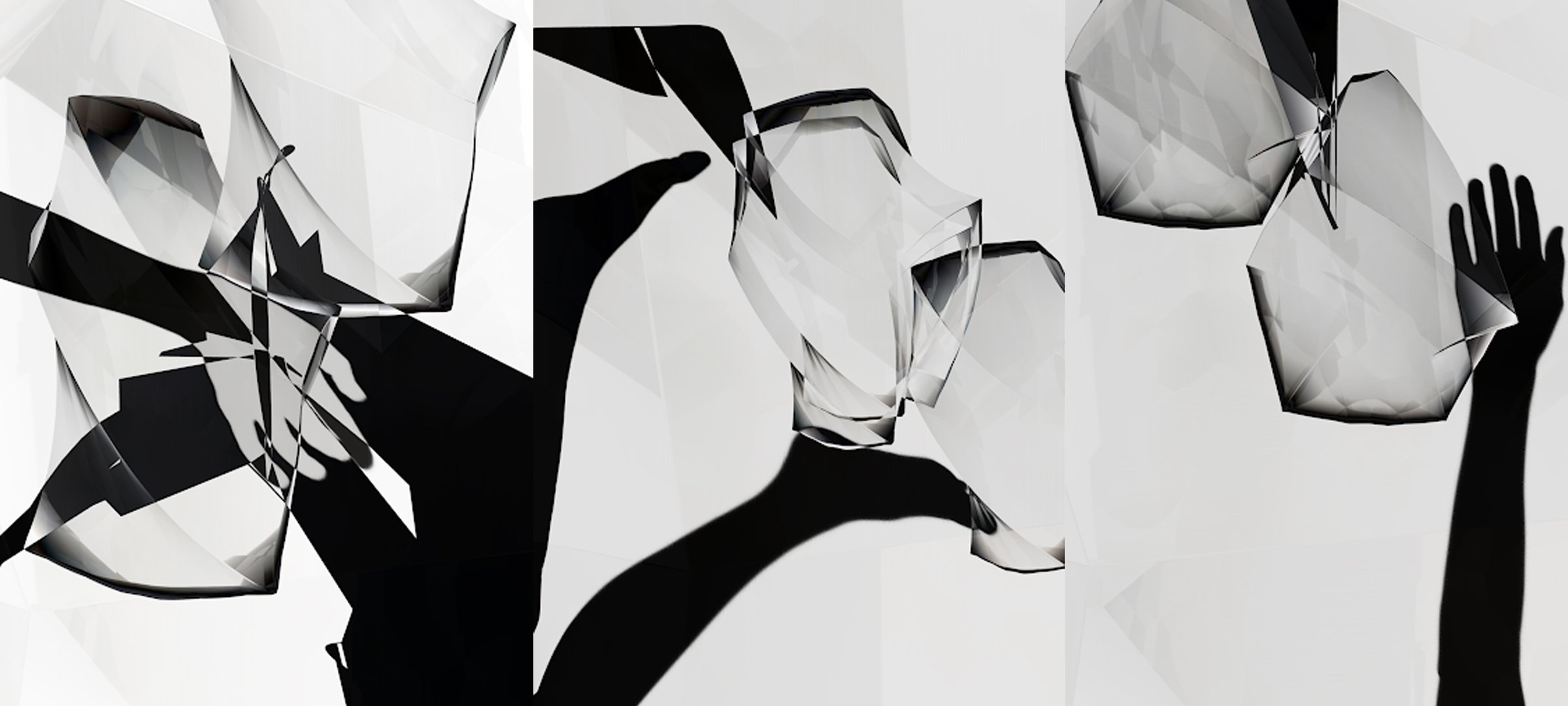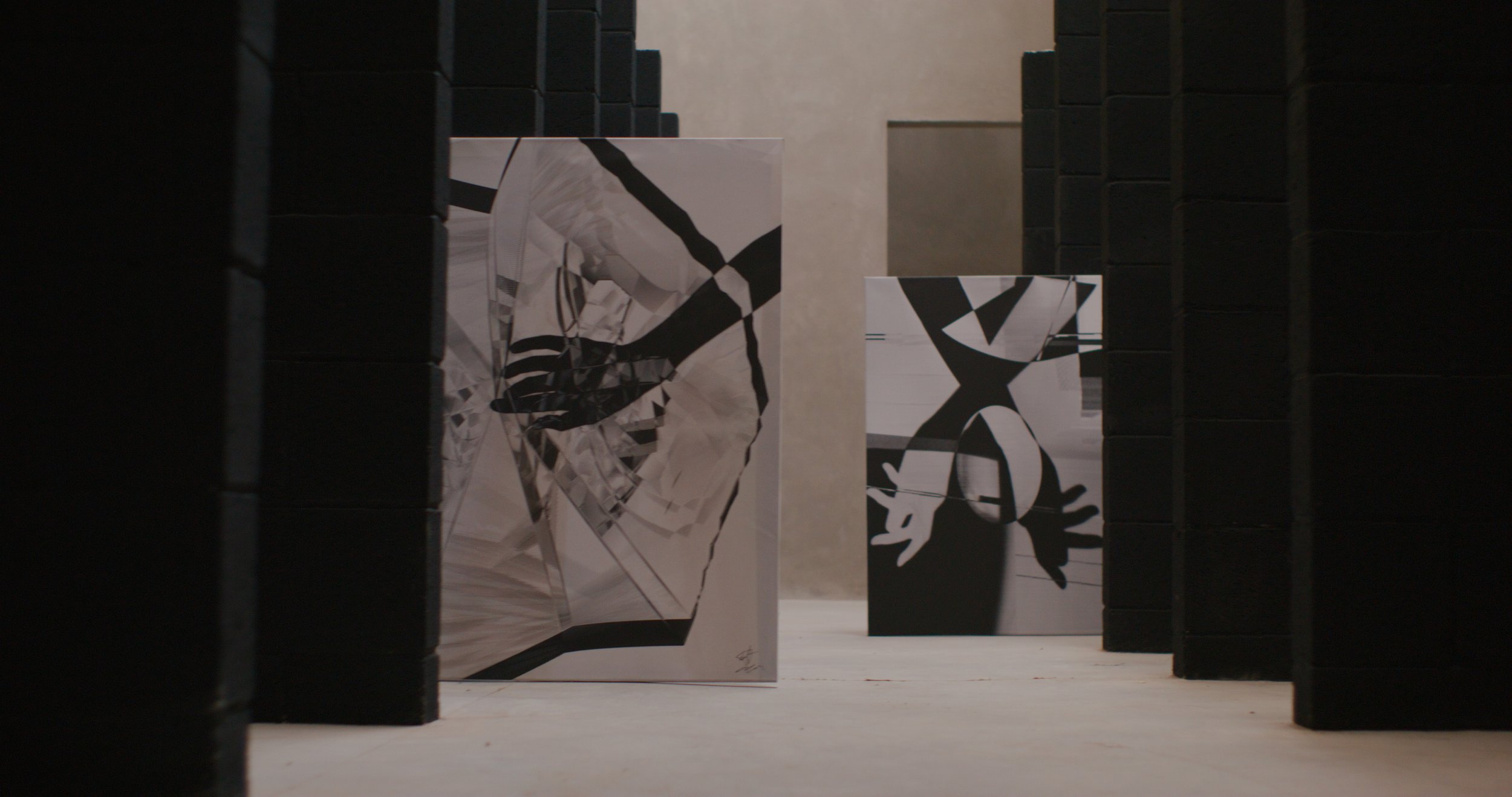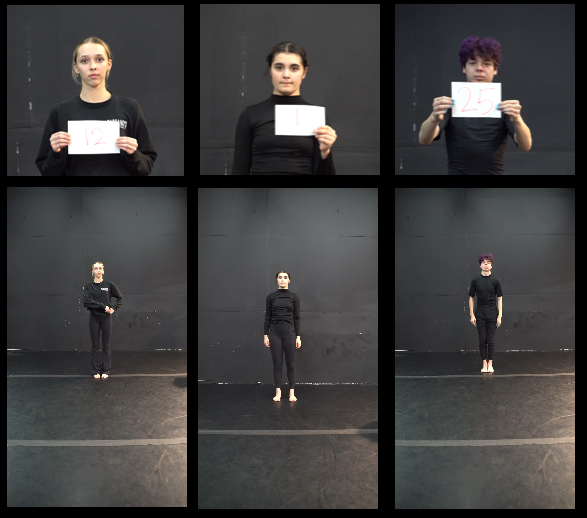
HUMAN
UNREADABLE
CONCEPT: THE SLOW RECOVERY OF THE HUMAN
Through the three phases of the work, 1) the mint on Art Blocks, 2) the uncovering of the movement sequence, and 3) the final performance, the audience-participant/collector embarks on a process of slowly recovering the human. After the mint, the human is still unreadable–abstracted, visible only through the result of movement on glass, buried in code. In the next phase of the work, one gets a glimpse at the underlying movement sequence via the unlocking of a movement score token. In the final phase of the recovery, the performance, one is faced–human to human–having life breathed into the movement that has been lying dormant inside their piece by a dancer, live.
Human Unreadable intentionally punctures the safety of modernist design and the idea of a universal voice, by pushing the limits of human expression within rigid technical systems. With a focus on the body, the collection brings risk, confusion, and vulnerability to the reveal, everything that the function-focused “reveal” design normally prevents. Each piece is an invitation, a transparent layer through which the human experience can come into focus after the reveal. This is an intentional continuation of the rejection of modernism, symmetry and clean lines in favor of more embodied and sensual approaches to human-machine collaboration pioneered by early women in digital art.
In Human Unreadable’s features list, there are no visual features—only choreographic features are present. A few example features include: Sequence length, Number of unique moves, Repetition, Tempo, Stage Orientation, Heart Distance Traveled.
Literally and figuratively, Operator has introduced vulnerability as a feature. Each piece has a vulnerability score with potential values being: Guarded, Door Cracked Open, and Vulnerable. In tech, vulnerabilities are problems that need to be fixed. Operator in this choice shifts the conversation around vulnerability from something to be avoided to something desirable.
BACKGROUND
Human Unreadable represents a synthesis of the duo's multifaceted work bringing together conceptual art, immersive technology, choreography, audience participation, and performance into a singular experience evolving over the course of 2023.
Influenced by the spirit of Black Mountain College and E.A.T. (Experiments in Art and Technology) movement of the 1960s, this work builds on Catherine and Ti’s 7 yr collaborative practice, pulling forth and challenging the best of both Ti’s extensive background as an HCI technologist & multimedia artist and Catherine’s background as a choreographer & performance artist, each spearheading their own half of a 25+ strong team ranging from specialized engineers to dancers. Together, they embarked on a 9 month process to realize their work; its foundation - a novel on chain generative choreography method.
PROCESS
1
ANALOG BEGINNINGS
First, through extensive experimentation, we developed a movement library of distinct movements and used analog generative models to produce random choreographic sequences. We worked for many months with teams of dancers in studios and residencies across France, Mexico and the US, to refine the movement library until the generated sequences were consistently desirable.
2
REVISE REVISE REVISE REVISE REVISE ETC
Second, Ania Catherine performed the library of movements in a state-of-the-art motion capture suit and used cinema-grade tech to turn our catalog of human motion into a vibrant and extensive data set.
3
HIDING THE BODY - MOVEMENT TO CODE
The human motion data in its raw form–due to immense size–was unsuited for blockchain. To resolve this issue, we developed a suite of custom inspection and downsampling tools- a brand new pipeline from FBX > CSV > JSON, innovating new ways of manipulating choreography in spreadsheets and Jupyter. The result, a hash per bone calculation, defining which body parts must be "buried" on chain to communicate the essence of each movement. Only readable to computers, fully obfuscated to the human intellect. The body is there, the movement is there, hidden in plain sight.
4
BUT WHAT DOES IT LOOK LIKE?
Five months later, we had the data and tools to synthesize the outputs on Art Blocks. We used mathematics to create generative glass. We turned numbers and data from spreadsheets into shadows of the human body, using complex methods to store them on chain. The subtlety of transparent materials playing just below the surface illustrated our idea as we used light, X-ray, glass... all coming together in a generative model - our very own digital X-ray - shedding cryptic light on each unique piece of code.

Hidden underneath each piece is a unique choreographic sequence, the beating heart of the work. Isolated moments of embodied expression become code, texture, story. What you don’t immediately see in the output is the invisible potentiality for performance. The collector is in a state of partial knowledge between the mint and the moment of seeing their sequence performed.
THE SLOW RECOVERY OF THE HUMAN
Through the three phases of the work, 1) the mint on Art Blocks, 2) the uncovering of the movement sequence, and 3) the final performance, the audience-participant/collector embarks on a process of slowly recovering the human. After the mint, the human is still unreadable–abstracted, visible only through the result of movement on glass, buried in code. In the next phase of the work, one gets a glimpse at the underlying movement sequence via the unlocking of a movement score token. In the final phase of the recovery, the performance, one is faced–human to human–having life breathed into the movement that has been lying dormant inside their piece by a dancer, live.
Human Unreadable intentionally punctures the safety of modernist design and the idea of a universal voice, by pushing the limits of human expression within rigid technical systems. With a focus on the body, the collection brings risk, confusion, and vulnerability to the reveal, everything that the function-focused “reveal” design normally prevents. Each piece is an invitation, a transparent layer through which the human experience can come into focus after the reveal. This is an intentional continuation of the rejection of modernism, symmetry and clean lines in favor of more embodied and sensual approaches to human-machine collaboration pioneered by early women in digital art.
In Human Unreadable’s features list, there are no visual features—only choreographic features are present. A few example features include: Sequence length, Number of unique moves, Repetition, Tempo, Stage Orientation, Heart Distance Traveled.
Literally and figuratively, Operator has introduced vulnerability as a feature. Each piece has a vulnerability score with potential values being: Guarded, Door Cracked Open, and Vulnerable. In tech, vulnerabilities are problems that need to be fixed. Operator in this choice shifts the conversation around vulnerability from something to be avoided to something desirable.

THE SLOW RECOVERY OF THE HUMAN IN THREE ACTS:
1: REVEAL
[Mint on Art Blocks]
The experience begins with collectors minting the works on Art Blocks. Comprised of the human body, generative glass and an x-ray shader, the artwork outputs are chaotic and visceral, despite being created entirely with code. The visual parameters and compositions are determined by human motion data.
Underneath each piece, a unique choreographic sequence waits to be uncovered.
2: DECIPHER
[Uncover underlying choreography via second token]
Using their minted token, collectors visit the Operator site to reveal their unique movement sequence, which takes the form of a fully on-chain movement score soul bound to their Art Blocks token.
3: WITNESS
[Attend live performance]
Each sequence in the collection will come to life in a series of live performances - institutions to be announced.




























